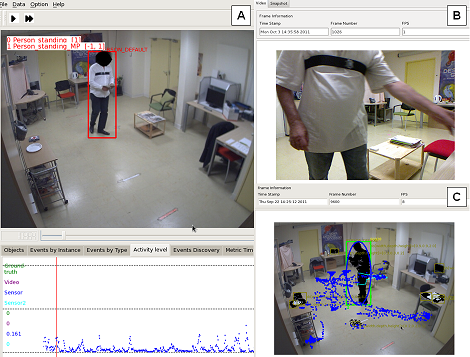Section: New Results
A Model-based Framework for Activity Recognition of Older People using Multiple sensors
Participants : Carlos -Fernando Crispim Junior, Qiao Ma, Baptiste Fosty, Cintia Corti, Véronique Joumier, Philippe Robert, Alexandra Konig, François Brémond, Monique Thonnat.
keywords: Activity Recognition, Multi-sensor Analysis, Surveillance System, Older people, Frailty assessment
We have been investigating a model-based activity recognition framework for the automatic detection of physical activity tests and instrumental activities of daily living (IADL, e.g., preparing coffee, making a phone call) of older people. The activities are modelled using a constraint-based approach (using spatial, temporal, and a priori information of the scene), and a generic ontology based on natural terms which allows medical experts to easily modify the defined activity models. Activity models are organized in a hierarchical structure according to their complexity (Primitive state, Composite State, Primitive Event, and Composite Event). The framework has been tested as a system on the clinical protocol developed by the Memory Center of Nice hospital. This clinical protocol aims at studying how ICTs (Information and Communication Technologies) can provide objective evidence of early symptoms of Alzheimer's disease (AD) and related conditions (like Memory Cognitive Impairment - MCI). The Clinical protocol participants are recorded using a RGB video-camera (8 fps), a RGB-D Camera (Kinect - Microsoft), and an inertial sensor (MotionPod) which allows a multi-sensor evaluation of the activities of the participants in an observation room equipped with home appliances. A study of the use of a multi-sensor monitoring for Patient diagnosis using events annotated by experts has been performed in partnership with CHU-Nice and SMILE team of TAIWAN, and it has shown the feasibility of the use of these sensors for patient performance evaluation and differentiation of clinical protocol groups (Alzheimer's disease and healthy participants) [31] and [40] . The multi-sensor evaluation has used the proposed surveillance system prototype and has been able to detect the full set of physical activities of the scenario 1 of the clinical protocol (e.g., Guided a ctivities : Balance test, Repeated Transfer Test), with a true positive rate of 96.9% to 100% for a set of 38 patients (MCI=19, Alzheimer=9) using data of an ambient camera. An extension of the developed framework has been investigated to handle multiple sensors data in the event modeling. In this new scenario, information from the ambient camera and the inertial sensor worn on the participants chest is used (see Figure 28 ). The prototype using the extended framework has been tested on the automatic detection of IADLs, and preliminary results points to an average sensitivity of 91% and an average precision of 83.5%. This evaluation has been performed for 9 participants videos (15 min each, healthy: 4, MCI: 5). See [39] for more details. Future work will focus on a learning mechanism to automatic fuse events detected by a set of heterogeneous sensors, and at supporting clinicians at the task of studying differences between the activity profile of healthy participants and early to moderate stage Alzheimer's patients.
|



